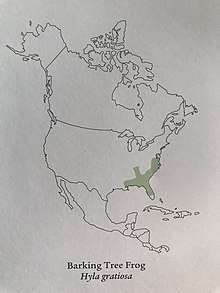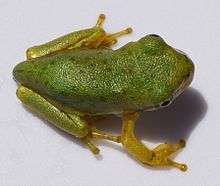Dryophytes gratiosus
Dryophytes gratiosus, commonly known as the barking tree frog, is a species of tree frog endemic to the south-eastern United States.
| Barking tree frog | |
|---|---|
| Scientific classification | |
| Kingdom: | Animalia |
| Phylum: | Chordata |
| Class: | Amphibia |
| Order: | Anura |
| Family: | Hylidae |
| Genus: | Dryophytes |
| Species: | D. gratiosus |
| Binomial name | |
| Dryophytes gratiosus (LeConte, 1856) | |
| Synonyms | |
| |
Geographic range

It is found from Delaware to southern Florida and eastern Louisiana, usually in coastal areas. There are also some isolated colonies in Maryland, Kentucky, and Tennessee.
Description
Dryophytes gratiosus is the largest native tree frog in the United States, acquiring its name from the raucous and explosive call.[2] It is 5 to 7 cm (2.0 to 2.8 in) in head-body length.[3] It is variable in color, but easily recognizable due to the characteristic dark, round markings on its dorsum. Individuals may be bright or dull green, brown, yellowish, or gray in color with small, grey and green-yellow spots. It has prominent, round toe pads, and the male has a large vocal sac. Dryophytes gratiosus has skin that is unlike any other species of American frog.[2] Its skin is neither rough and warty not smooth, having skin that is thick and leathery. Its skin can also shift colors depending on lighting, time of day, temperature, or its surroundings.[3] Changes in color can be rapid and the spots can seem to disappear and reappear over time.[2] The eyes of Dryophytes gratiosus are brown, gold, and black.
Behavior

The barking tree frog is known for its loud, strident, barking call. It may also utter a repetitive single-syllable mating call. It has been known to chorus with other frogs of the same and similar species. Furthermore, during mating, a female D. gratiosus is more likely to pick an attractive mating call unless if it is more than five meters away.[4]
The barking tree frog burrows in the sand, especially when the temperature is hot. It also spends time high up in trees, especially during the day when it is less active.
Habitat
Adult Dryophytes gratiosus usually live in trees or bushes. They can also burrow deep into mud and logs for added protection from predators.
Mating and Breeding
Dryophytes gratiosus is a polygynous species, the female choosing the male on the basis of his call. It reproduces aquatically. Adults migrate to land to lay their eggs, usually alone. Breeding typically occurs over two or three months, the months differing depending on the location. In Kentucky, Dryophytes gratiosus usually breads between mid June to late July, April to July in North Carolina and Alabama, and March to August in Louisiana and Florida.[5] After mating, both genders move inland to higher grasses. Females lay anywhere from 1,500 and 4,00 eggs at a time.[5] When these eggs hatch, grow into tadpoles, or the tailed larva of an amphibian. Tadpoles can be nearly 5 cm (2.0 in) in length.
Conservation Status
According to the ICUN Red List, Dryophytes gratiosus is of the status of Least Concern as of March 2019.[6]
References
- Hammerson, G. 2004. Hyla gratiosa. In: IUCN 2012. IUCN Red List of Threatened Species. Version 2012.2. Downloaded on 04 June 2013.
- P., Badger, David (1995). Frogs. Netherton, John. Stillwater, MN: Voyageur Press. ISBN 0896583147. OCLC 32131986.
- "Barking Tree Frog: Stats & Facts". Animal Planet. 2012-05-15. Retrieved 2019-03-11.
- Murphy, Christopher G. (2012). "Simultaneous mate-sampling by female barking treefrogs (Hyla gratiosa)". Behavioral Ecology. 23 (6): 1162–1169. doi:10.1093/beheco/ars093.
- "AmphibiaWeb - Hyla gratiosa". amphibiaweb.org. Retrieved 2019-03-11.
- "The IUCN Red List of Threatened Species". IUCN Red List of Threatened Species. Retrieved 2019-03-11.
External links
![]()
![]()
